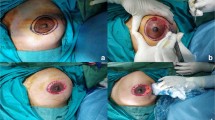Abstract
The modified round block technique (MRBT) is a level I oncoplastic breast-conserving surgery (OBCS), which contains a very wide glandular flap created by extensive dual-plane undermining that is achieved by entire subcutaneous dissection and approximately 50% dissection of the breast parenchyma from the pectoralis muscle. A retrospective analysis was performed for 100 patients who underwent OBCS using MRBT from February 2009 to October 2017. The incidence of positive margin was 7.0% (seven cases), and there has been no local recurrence during a median follow-up period of 68 months. Short- and long-term complications included fat necrosis (11.0%), infection (4.0%), and hematoma formation (4.0%). When patients were divided into two groups based upon the preoperative mammography findings, fat necrosis occurred in 5.2% of the patients with extremely dense or heterogeneously dense mammography, and in 19.0% of patients with scattered fibroglandular or entire fat mammography, which showed a statistically significant difference. Therefore, in level I OBCS, the extent of dual-plane undermining should be minimized to less than 50% of the total parenchyma in fatty breasts.




Similar content being viewed by others
References
Clough KB, Kaufman GJ, Nos C, Buccimazza I, Sarfati IM. Improving breast cancer surgery: a classification and quadrant per quadrant atlas for oncoplastic surgery. Ann Surg Oncol. 2010;17:1375–91.
Zaha H, Onomura M, Unesoko M. A new scarless oncoplastic breast-conserving surgery: modified round block technique. Breast. 2013;22:1184–8.
Würinger E, Mader N, Posch E, Holle J. Nerve and vessel supplying ligamentous suspension of the mammary gland. Plast Reconstr Surg. 1998;101:1486–93.
Mercado CL. BI-RADS update. Radiol Clin N A. 2014;52:481–7.
Morimoto T, Okazaki M, Endo T. Current status and goals of mammographic screening for breast cancer in Japan. Breast Cancer. 2004;11:73–81.
Rao A, Saadeh PB. Defining fat necrosis in plastic surgery. Plast Reconstr Surg. 2014;134:1202–12.
Harris JR, Levene MB, Svensson G, Hellman S. Analysis of cosmetic results following primary radiation therapy for stages I and II carcinoma of the breast. Int J Radiat Oncol Biol Phys. 1979;5:257–61.
Cordoso JS, Cardoso MJ. Towards an intelligent medical system for the aesthetic evaluation of breast cancer conservative treatment. Artif Intell Med. 2007;40:115–26.
Moran MS, Schnitt SJ, Giuliano AE, Harris JR, Khan SA, Horton J, et al. Society of Surgical Oncology–American Society for Radiation Oncology consensus guideline on margins for breast-conserving surgery with whole-breast irradiation in stages I and II invasive breast cancer. Ann Surg Oncol. 2014;21:704–16.
Morrow M, Van Zee KJ, Solin LJ, Houssami N, Chavez-MacGregor M, Harris JR, et al. Society of Surgical Oncology–American Society for Radiation Oncology–American Society of Clinical Oncology consensus guideline on margins for breast-conserving surgery with whole-breast irradiation in ductal carcinoma in situ. Ann Surg Oncol. 2016;23:3801–10.
Dolan R, Patel M, Weiler-Mithoff E, Mansell J, Stallard S, Doughty JC, et al. Imaging results following oncoplastic and standard breast conserving surgery. Breast Care (Basel). 2015;10:325–9.
Funding
This study received no specific grant from any funding agency in the public, commercial, or not-for-profit sectors.
Author information
Authors and Affiliations
Corresponding author
Ethics declarations
Conflict of interest
Hisamitsu Zaha declares that he/she has no conflict of interest. Tokiwa Motonari declares that he/she has no conflict of interest. Norie Abe declares that he/she has no conflict of interest. Mikiko Unesoko declares that he/she has no conflict of interest.
Ethical approval
All procedures performed in studies involving human participants were in accordance with the ethical standards of the institutional research committee and with the 1964 Helsinki Declaration and its later amendments or comparable ethical standards.
Informed consent
Informed consent was obtained from all individual participants included in the study.
Additional information
Publisher's Note
Springer Nature remains neutral with regard to jurisdictional claims in published maps and institutional affiliations.
About this article
Cite this article
Zaha, H., Motonari, T., Abe, N. et al. Fat necrosis in level I oncoplastic breast-conserving surgery focusing on a modified round block technique. Breast Cancer 27, 567–572 (2020). https://doi.org/10.1007/s12282-020-01046-7
Received:
Accepted:
Published:
Issue Date:
DOI: https://doi.org/10.1007/s12282-020-01046-7




